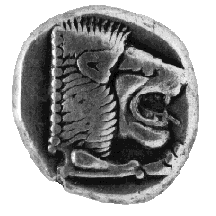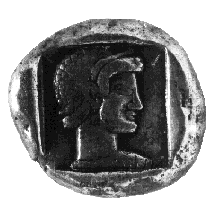



(35) Knidos, Caria (Turkey) - AR drachm, c. 520-490 B.C.,
6.15 g. (inv. 91.084).
Obverse: Forepart of lion r.
Reverse: In incuse square, head of Aphrodite r.
Provenance: Ex Massachusetts Historical Society collection;
Stack's, 1971.
Bibliography: H.A. Cahn, Knidos: die Münzen des
sechsten und des fünften Jahrhunderts v. Chr. (Berlin 1970) pl.
3, no. 46.
Knidos was a Greek colony in southwestern Asia Minor, situated partly on
the mainland and partly on an island connected to it with two moles. Its
harbor and location made it an important port. Knidos was part of a federation
of six neighboring cities (including Lindos, Kamiros and Ialysos on Rhodes,
and Kos and Halikarnassos) called the Dorian Hexapolis. The coinage of Knidos
begins in the late sixth century B.C. and consists mostly of drachms.
The images on Knidian coins refer to the city's major cults. On the obverse
is the forepart of a lion,
attribute of Apollo. In Knidos he was worshipped as the sun god Triopian
Apollo; every four years the federation met in his sanctuary for the Dorian
Games in his honor. The other major cult at Knidos was that of Aphrodite
Euploia, the aspect of the goddess which protected ships and seafaring.
The head of Aphrodite appears on the reverse. The style of the reverse,
with its old-fashioned incuse square and Aphrodite's frontal eye and bead-like
hair, are evidence of a date in the Archaic period of Greek art.
R.H.L.



All contents copyright (c) 1996.
Lawrence University
All rights reserved.